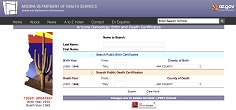Use of historical death certificates as a tool to study the changing dynamics of human populations
ABSTRACTPopulation characteristics change through time and in response to shifting environmental and demographic conditions. A life table uses information about age-specific mortality rates to determine patterns of survivorship and mortality. In this demography and ecology exercise, small groups of students learn about the concept of demographic and epidemiological transition, using a web-based, statewide historical death certificate database. Students create life tables, survivorship curves, and causes of mortality tables to analyze the data collected. This exercise could be modified to study a diverse number of topics and compare other demographic characteristics, such as geographic regions, time periods, sex, and race/ethnicity. AUTHORSDiana I. Ortiz1 and Tia M. Kowalo2 1Biology Program, Westminster College, New Wilmington, PA 16172 2Environmental Science Program, Westminster College, New Wilmington, PA 16172 Corresponding author: Diana I. Ortiz, ortizdi@westminster.edu CLASS TIMEThree, three-hour labs. In the first lab period, students learn how to navigate through the online death certificate database, conduct background research, define their study questions, hypothesis and predictions, design their study methods, and collect data. During the second period, students complete their data collection, construct life tables, calculate survivorship curves, and cause-specific mortality. During the last lab period, students present the results of their projects through a poster or oral presentation. OUTSIDE OF CLASS TIMEApproximately three to four hours per student team (2-3 students per team) to collect and analyze data and prepare a presentation for the class. STUDENT PRODUCTSIn order to assess the students’ work, each group provides a presentation during class. Students present: (1) background that provides a rationale for their question(s), (2) their research question(s), hypothesis, and methods, (3) their results, including tables and graphs generated, (4) their interpretation on the significance of the results, and (5) weaknesses and strengths of their study. Alternatively, each group may produce a research poster or research paper as part of their lab assessment. Guidelines for presentations are provided to students ahead of time. SETTINGOne of the strengths of this learning experience is that it can be done year-round using student or school-owned computers connected to the internet. The last lab period may require a room with a projector for presentations. Students also need access to a random number generator (e.g., Open Epi website) or a random number table and the Arizona Genealogy Birth and Death Certificate (AGBDC) database, which they can access online https://genealogy.az.gov). This database contains microfilmed images of county or state-issued death certificates from 1870 to 1969 that have been made available to the public. Students could also conduct this exercise using the open-access digitized Missouri Death Certificates database (1910-1969) httpss://s1.sos.mo.gov/records/archives/archivesmvc/deathcertificates. However, we selected the AGBDC for this exercise since it offers a more robust, user-friendly search engine and it covers a longer time period than the Missouri death certificate database. COURSE CONTEXTThis lab can be taught at any time of the year. We have used it in a junior-level or senior-level epidemiology course with 10-20 students. Students work cooperatively in groups of two to three. INSTITUTIONThis lab is used at a private, liberal arts college. TRANSFERABILITYThis lab can be used in any general biology, introduction to biology, and environmental science course. More extensive study designs, data collection, and analysis could be required in advanced courses, such as ecology and epidemiology, especially if students have basic statistical knowledge. This exercise also could be modified for non-majors by scaling down the scope of the exercise. No specialized equipment is necessary. Easy access to the AGBDC online database reduces the limitations imposed by geography, travel time and expense, and any mobility impairments students may have. Since time available for oral presentations could be a limiting factor, poster presentations or written reports also could be used as assessment tools. DOWNLOADSDescription of other Resource Files:
ACKNOWLEDGMENTSThe laboratory exercise described here was conceived by the desire to provide biology students with a hands-on, comprehensive, data-rich exercise that assessed their critical thinking skills in ecology, demography, and epidemiology. A few years ago, we developed an ecology exercise utilizing an online database of Mennonite obituaries used to analyze life tables and survivorship curves. The exercise is also inspired by previously published cemetery and public obituary laboratory exercises (Flood 1993, Lanza 2012). We want to extend our gratitude to Dr. Helen Boylan-Funari and Eloise Stevens at Westminster College for their thoughtful suggestions on improving this article and finding sources of information. CITATIONDiana I. Ortiz and Tia M. Kowalo. 15 August 2020, posting date. Use of historical death certificates as a tool to study the changing dynamics of human populations. Teaching Issues and Experiments in Ecology, Vol. 16: Experiment #3 [online]. https://tiee.esa.org/vol/v16/experiments/ortiz/abstract.html |

Main page of the Arizona Genealogical Birth and Death Certificate (AGBDC) database website. full size image |
<top> | |